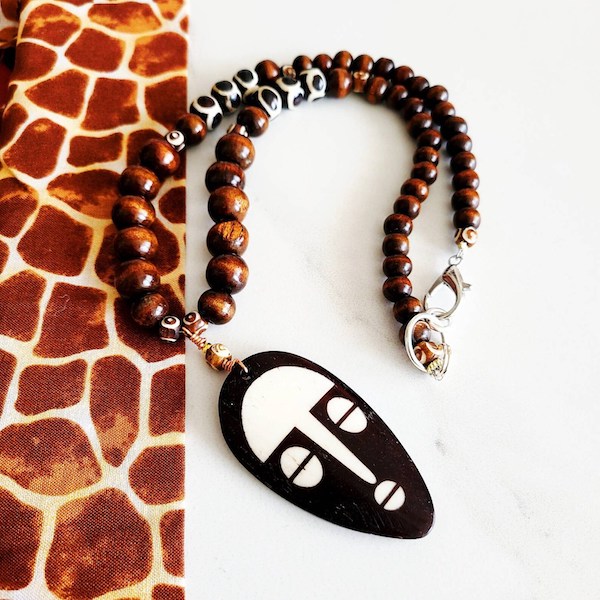Delaware based Abeni of KheperaAdornments explains how she got her unusual name :
I am affectionately called Abeni (AH-Ben-ee); a name of Yoruba origin meaning, "We asked for her and behold, we got her". I am a lover of all things natural. Given my love for travel, I share a few of my international finds from time to time, in addition to offering meaningful adornments with bright and vibrant colors and earth tones.The Yoruba is an ethnic group in West Africa. She has a collection of wonderful African findings made into modern style jewelry. These include symbols from the more familiar Ancient Egyptian designs to ones from West Africa.
Shown below are some of my favorites especially the mask designs. Her cowrie shell collection is also noteworthy.
She described her jewelry line "esoteric" which means limited to a small group with specialized knowledge or interests. But it need not be.
 |
| West African Mask Ring |
 |
| Queen Mother Idia Benine Empire Mask Pendant Necklace |
 |
| Guinea Mask Jewelry Set |
 |
| Queen Nefertiti ring |
 |
| Gye Nyame - Adinkra (West Africa) omnipotent symbol meaning "Except God" |
 |
| Egyptian Falcon and Ankh earrings |
 |
| Conch shell ear cuff |
 |
| African Double Headed Axe Pendant Necklace |
 |
| African Bone Mask Pendant |
 |
| Adinkra (West African) symbol (Funtunfunefu Denkyemfunefu or conjoined crocodiles) representing democracy and cooperation The Real Lion King | The Mali Empire of Africa Today, we are learning more about the rich, cultural history of African
civilizations and empires. This hasn't been the case as it's not taught
in schools, and the narrow narratives of European colonizers excluded
their stories in ignorance and to empower their own view of supremacy. Much of what we
know about these great empires was not written but passed down orally
through generations of storytellers called griots. The only written
records came from Arabic sources as traders crossed the Sahara to trade in gold and rock salt in the great West African Empires of Ghana (3rd - 11th century AD), Mali (13th- 17th century AD) and Songhai (15th-16th century AD). |
 |
| Map Credit : Gabriel Moss |
Disney didn't dream up the story of The Lion King out of thin air. There really was a Lion King. He was Sundiata Kieta, a prince of the Madinka people and the founder of the mighty Mali Empire in Medieval age. His father, King Naré Maghann Konaté, was the real life Mufasa. Although Sundiata was born crippled, he eventually overcame his disability and became a strong leader and was highly favored by his father. His half brother, Dankaran Touran, was jealous and coveted the throne for himself.
Foul play was suspected when the King died. This forced Sundiata, his mother and other siblings to flee into exile in fear of their lives. The Madinka people were then conquered by a cruel ruler, King Soumaro Kante of the Sosso. The people sent word to Sundiata to return and claim his rightful throne which he did after forming powerful alliances with other rulers. He became the Mansa which means "King" or "Emperor" in Madinka.
The most famous ruler of the Mali Empire was his grand-nephew, Mansa Musa who is thought to have been the richest man ever with a possible total wealth of $400 billion ( - today's richest billionare does not top $250 billion) - no one really knows just how rich he was but the wealth came from trade in Mali's rock salt and gold resources as well as in ivory. Mansa Musa expanded and ruled over a huge empire which stretched for 2,000 miles from the Atlantic Ocean all the way to modern Niger. His reign (1312- 1337) was probably the Mali Empire at its peak and certainly the best known.
The Arabs brought Islam to the area and Mansa Musa, as a devout Muslim, made a spectacular haj or pilgrimage to Mecca in 1324. His court entourage, a moving city of tens of thousands of people - merchants, soldiers, griots, servants, slaves, camel and animal drivers with thousands of animals herded along. Each camel carried about 300 lb of gold. He spent so much gold when he was in Cairo, Egypt for 3 months, the price of gold plummeted and remained low for over 10 years.
He returned with several Arabic scholars in tow and made Timbuktu into a renowned cultural centre of learning with its own university. He built many schools, mosques and libraries.
His fame was such that he appears in the 1375 medieval world map called the Catalan Atlas.
 |
| Mansa Musa holding a gold coin |
Timbuktu became the African El Dorado with tales of its immense wealth filtering down through the centuries. This eventually drew in European explorers, fortune hunters and plunderers.
References
- The True Story Behind the Lion King
- Is Mansa Musa the Richest Man Who Ever Lived
- National Geographic : Mansa Musa
Recommended Documentaries
BBC's Desert Empires : History of Africa . This is part of a unique and superb series of documentaries on Africa is presented by Zeinab Badawi, a Sudanese- British journalist.
This episode tells the story of the Ghana, Mali and Songhai Empires of West Africa as she journeys through the modern day lands.

very interesting, thanks for sharing!
ReplyDeleteGorgeous findings and fascinating history!
ReplyDelete